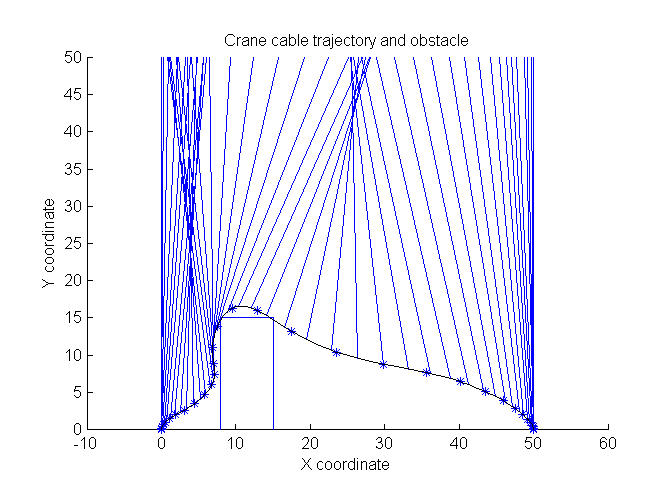PROPT Jumbo Crane Container Control
From TomWiki
Jump to navigationJump to search
|
This page is part of the PROPT Manual. See PROPT Manual. |
Problem description
Time-optimal control of a Jumbo Container Crane avoiding an obstacle.
Crane dynamics described in the book: Informatics in control automation and robotics II DOI 10.1007/978-1-4020-5626-0 , Springer, 2007, pp.79-84. T.J.J. van den Boom, J.B. Klaassens, R. Meiland Real-time optimal control for a non linear container crane using a neural network
Optimal control problem by: W.L. De Koning, G Fitie and L.G. Van Willigenburg
Programmers: Gerard Van Willigenburg (Wageningen University) Willem De Koning (retired from Delft University of Technology)
% Copyright (c) 2009-2009 by Tomlab Optimization Inc.Problem setup
% Array with consecutive number of collocation points
narr = [8 10 40];
toms t t_f % Free final time
toms ho1
for i=1:length(narr)
p = tomPhase('p', t, 0, t_f, narr(i), [], 'cheb');
setPhase(p)
tomStates x1 x2 x3 x4 x5 x6
tomControls u1 u2
x = [x1; x2; x3; x4; x5; x6];
% Crane parameters
gr = 9.81; He = 50; Jh = 35.6; Jt = 13.5; ht = 50;
mc = 47000; mt = 33000; Nh = 26.14; Nt = 16.15; rh = 0.6; rt = 0.5;
xo_l = 8; xo_r = 15; hob = 15;
% Initial & terminal states
xi = [0; 0; 0; 0; 50; 0];
xf = [50; 0; 0; 0; 50; 0];
% Initial guess
if i==1;
x0 = {t_f==20.4; ho1==0; icollocate({x1 == 50*t/20; x2 == xi(2)
x3 == xi(3); x4 == xi(4); x5 == xi(5); x6 == xi(6)})
collocate({u1 == -2000; u2 == -5000})};
else
x0 = {t_f==tfopt;
icollocate({x1 == xopt1; x2 == xopt2
x3 == xopt3; x4 == xopt4; x5 == xopt5; x6 == xopt6})
collocate({u1 == uopt1; u2 == uopt2})};
end
% Box constraints
cbox = {15 <= t_f <= 30; -4200 <= collocate(u1) <= 4200
-11490 <= collocate(u2) <= 11490};
% Boundary constraints
cbnd = {initial(x == xi), final(x == xf)};
Gt = Jt*Nt*Nt/(rt*rt); Gh = Jh*Nh*Nh/(rh*rh);
st = sin(x3); ct = cos(x3);
Ft = (Nt/rt)*u1; Fh = (Nh/rh)*u2;
d2x = (mc+Gh)*Ft-mc*Fh.*st+mc*gr*Gh*st.*ct+mc*Gh*x5.*x4.*x4.*st;
d2x = d2x./((mc+Gh)*(mt+Gt)+mc*Gh*(1-ct.*ct));
% xc is the container x position against time
xc = x1+x5*sin(x3);
% hc is the height of the container against time
hc = ht-x5*cos(x3);
% ho is the height of the obstacle at the container x position.
%ho = ifThenElse(xc<=xo_l,0,ifThenElse(xc>=xo_r,0,hob));
% do is the distance to the obstacle from the container.
do = max(max(xo_l-xc,xc-xo_r),hc-ho1);
% Path constraint - Distance to obstacle should always be >= 0
% and height should always be >= 0.
% Test 300 points, evenly spaced in time.
pth = {atPoints(linspace(0,t_f,300),{do>=0,hc>=0}),ho1>=hob};
% ODEs
ode = collocate({
dot(x1) == x2
dot(x2) == d2x
dot(x3) == x4
dot(x4) == (-2*x6.*x4-gr*st-d2x.*ct)./x5
dot(x5) == x6
dot(x6) == (Fh+mc*x5.*x4.*x4+mc*gr*ct-mc*d2x.*st)/(mc+Gh)
});
% Objective
objective = t_f;Solve the problem
options = struct;
if i==1
% To improve convergece, we make the obstacle constraint softer,
% by including it in the ojbective rather than as a hard constraint
% in the first iteration.
% This is necessary because of the very nonlinear properties of this
% constraint.
pth = pth{1};
objective = objective - 2*ho1;
end
options.name = 'Crane with obstacle';
options.Prob.SOL.optPar(30) = 20000;
solution = ezsolve(objective, {cbox, cbnd, pth, ode}, x0, options);
tfopt = subs(t_f,solution);
xopt1 = subs(x1,solution);
xopt2 = subs(x2,solution);
xopt3 = subs(x3,solution);
xopt4 = subs(x4,solution);
xopt5 = subs(x5,solution);
xopt6 = subs(x6,solution);
uopt1 = subs(u1,solution);
uopt2 = subs(u2,solution);Problem type appears to be: lpcon
Time for symbolic processing: 0.90348 seconds
Starting numeric solver
===== * * * =================================================================== * * *
TOMLAB - TOMLAB Development license 999007. Valid to 2011-12-31
=====================================================================================
Problem: --- 1: Crane with obstacle f_k -26.541463723357047000
sum(|constr|) 0.000010131613776755
f(x_k) + sum(|constr|) -26.541453591743270000
f(x_0) 20.399999999999999000
Solver: snopt. EXIT=0. INFORM=1.
SNOPT 7.2-5 NLP code
Optimality conditions satisfied
FuncEv 1 ConstrEv 704 ConJacEv 702 Iter 108 MinorIter 10898
CPU time: 3.416422 sec. Elapsed time: 3.441000 sec.
Problem type appears to be: lpcon
Time for symbolic processing: 0.89601 seconds
Starting numeric solver
===== * * * =================================================================== * * *
TOMLAB - TOMLAB Development license 999007. Valid to 2011-12-31
=====================================================================================
Problem: --- 1: Crane with obstacle f_k 21.414232451352436000
sum(|constr|) 0.000000805251778330
f(x_k) + sum(|constr|) 21.414233256604216000
f(x_0) 30.000000000000000000
Solver: snopt. EXIT=0. INFORM=1.
SNOPT 7.2-5 NLP code
Optimality conditions satisfied
FuncEv 1 ConstrEv 429 ConJacEv 427 Iter 71 MinorIter 3226
CPU time: 2.106014 sec. Elapsed time: 2.067000 sec.
Problem type appears to be: lpcon
Time for symbolic processing: 0.90527 seconds
Starting numeric solver
===== * * * =================================================================== * * *
TOMLAB - TOMLAB Development license 999007. Valid to 2011-12-31
=====================================================================================
Problem: --- 1: Crane with obstacle f_k 19.836463017206320000
sum(|constr|) 0.000000094094453503
f(x_k) + sum(|constr|) 19.836463111300773000
f(x_0) 21.414232451352436000
Solver: snopt. EXIT=0. INFORM=1.
SNOPT 7.2-5 NLP code
Optimality conditions satisfied
FuncEv 1 ConstrEv 352 ConJacEv 350 Iter 52 MinorIter 1273
CPU time: 4.898431 sec. Elapsed time: 4.793000 sec.
end
% Get solution for 50 points, evenly distributed in time.
nt = 50;
topt = linspace(0,subs(t_f,solution),nt);
xopt = subs(atPoints(topt,x),solution);
% Plot
[nt,nx]=size(xopt);
clf
axis([-10 60 0 50]);
axis image;
% Draw Obstacle
line([xo_l xo_l xo_r xo_r],[0 hob hob 0]);
title('Crane cable trajectory and obstacle');
xtop=xopt(:,1); ytop=50*ones(size(topt));
xbottom=xopt(:,1)+xopt(:,5).*sin(xopt(:,3));
ybottom=50-xopt(:,5).*cos(xopt(:,3));
% Draw cable trajectory
tl=5; toptlen=length(topt);
for k=1:toptlen
line([xtop(k) xbottom(k)],[ytop(k) ybottom(k)]);
if tl/toptlen>0.01; pause(tl/toptlen); end
end
hold on; ezplot(xc,hc); hold off
xlabel('X coordinate'); ylabel('Y coordinate');